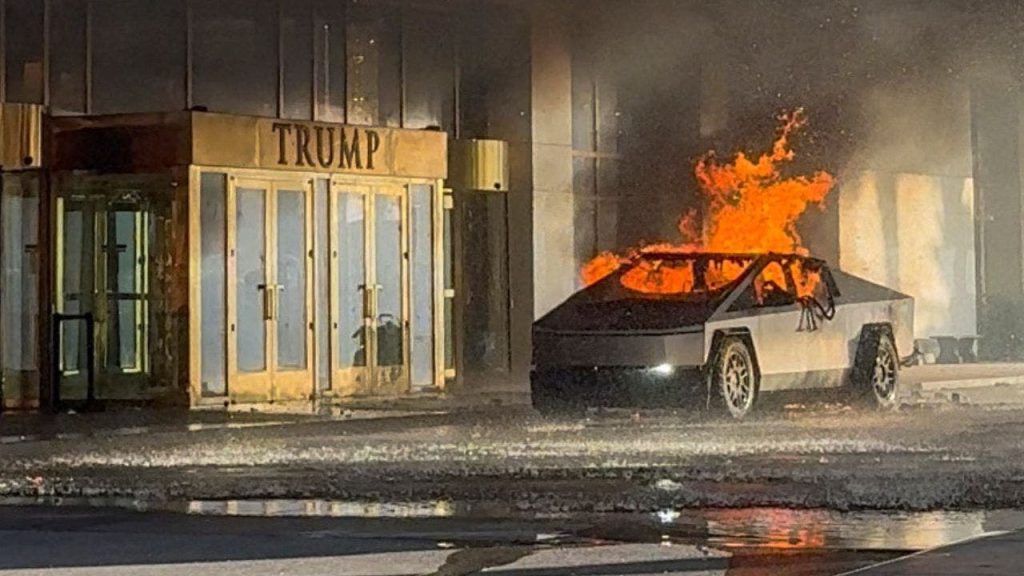The Mysterious Tesla Cybertruck Attack: More Questions Than Answers
The investigation into the New Year’s Day Tesla Cybertruck explosion outside Trump International Hotel in Las Vegas has yielded limited new insights, despite the release of a comprehensive 78-page “after-action” report by the Las Vegas Metropolitan Police Department (LVMPD). The report confirmed that Matthew Livelsberger, a Green Beret who died by suicide before the explosion, left behind a manifesto on his phone that investigators later recovered through forensic analysis. Curiously, the Department of War classified this manifesto as secret, transferring the investigation to federal authorities. This classification has created a veil of mystery around Livelsberger’s true motives, leaving the public with more questions than answers about what drove a Special Forces soldier to orchestrate such a dramatic and dangerous public attack.
According to the investigation, Livelsberger meticulously planned his actions. While on leave from his Special Forces unit, he rented a Tesla Cybertruck through the car-sharing platform Turo and proceeded to fill it with a dangerous combination of fireworks, gas cans, and camping fuel. On the morning of January 1, 2025, just after 8:40 a.m., he drove this makeshift bomb to the Trump International Hotel. Surveillance footage captured Livelsberger pouring accelerant into the truck bed moments before detonation, an action that investigators described as reflecting careful planning rather than impulsive behavior. The explosion caused significant property damage and injured six people, though authorities stopped short of labeling the incident as terrorism despite describing it as a premeditated vehicle-borne improvised explosive device (VBIED) attack “with the potential to cause mass casualties and extensive structural damage.”
By piecing together Livelsberger’s final days using phone data, bank records, and surveillance footage, investigators painted a portrait of a man determined to make what counterterrorism officials called “a very big, very public statement.” The choice of Las Vegas as a location appears deliberate, selected for its visibility and potential impact. This calculated approach suggests Livelsberger wanted his actions to receive maximum attention, choosing a prominent landmark in a city known globally for its tourism and media presence. The timing—New Year’s Day—also seems significant, potentially selected to coincide with a day of new beginnings and high visibility, when his message might reach the widest possible audience as the nation and world focused on celebration.
Perhaps most perplexing are Livelsberger’s own words about his actions, recovered from notes on his phone. “This was not a terrorist attack, it was a wake-up call,” he wrote, adding, “Americans only pay attention to spectacles and violence. What better way to get my point across than a stunt with fireworks and explosives.” These statements reveal a troubling logic: Livelsberger apparently believed that only through dramatic, violent spectacle could he capture the attention of an American public he perceived as otherwise disengaged or distracted. His note also criticized what he called the “feckless leadership” of a United States that is “near collapse,” suggesting deep disillusionment with the country’s direction and leadership. One of his messages was reportedly sent to Shawn Ryan, a former Navy SEAL and CIA contractor, though the content and purpose of this communication remain unclear.
The contrast between Livelsberger’s military service as a Green Beret and his violent final act creates a jarring dissonance that investigators have yet to fully explain. As a Special Forces soldier, he would have received extensive training and indoctrination focused on protecting American interests and citizens, making his attack on a civilian target all the more shocking and difficult to reconcile. His note claiming the attack was a way to “cleanse” his mind hints at possible psychological distress, but without access to the classified manifesto, understanding the full extent of his mental state and motivations remains impossible. This gap in public knowledge has fueled speculation about whether Livelsberger might have been influenced by political extremism, personal grievances, or experiences related to his military service.
The government’s decision to classify Livelsberger’s manifesto raises important questions about transparency and public safety. While there may be legitimate national security concerns warranting classification, this decision also prevents the public from fully understanding what motivated this attack and whether it represents an isolated incident or points to broader concerns among military personnel. The handoff of the investigation from local law enforcement to federal authorities suggests the case may have implications beyond a single violent act in Las Vegas. As this investigation continues behind closed doors, the public is left with a fragmented understanding of an event that, as Livelsberger himself noted, was designed specifically to capture American attention through spectacular violence. Without greater transparency, it remains difficult to extract meaningful lessons from this tragedy or to address any underlying issues that might have contributed to it.


